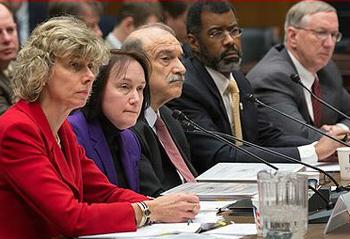Nuclear Energy Activist Toolkit #18
Five.
It’s the number of members in the Jackson 5. And it’s also the number of members on the Nuclear Regulatory Commission.
In the former case, singing from the same page was mandatory. Singing off-key or not in harmony was a professional sin.
In the latter case, singing from different pages – at least initially – was deliberately built in for good reason.
Each NRC commissioner serves a five-year term. The terms are staggered such that a commissioner’s term expires June 30 of every year. By law, no more than three commissioners can be from the same political page. This measure lessens political influence on the NRC.
Such built-in diversity helps the Commission reach decisions about nuclear safety. The most valuable lesson I learned from Dr. Pietro “Pete” Pasqua, who headed the nuclear engineering department at the University of Tennessee, was that having all the right answers is only sufficient when all the right questions have been asked. The Commission’s diversity asks more questions yielding more answers that better inform its decisions.
The five commissioners could not be convicted of being from the same mold, even when tested on factors other than political party affiliation. While all commissioners have policy awareness, some have extensive experience and deep interest in policy matters. Other commissioners pair their policy awareness with considerable experience on the implementation side of policy decisions. And other commissioners have solid understanding of the tools of the trade used when implementing policy decisions. This broad array of backgrounds, skills, and interests helps the Commission probe safety issues before it more thoroughly than any one commissioner – or five of the same kind – could.
A disadvantage of a commission compared to a single administrator is that an administrator’s machinations and conflicting viewpoints en route to a final decision are private. When commissioners embarking from five different places do not converge to a unanimous endpoint, their differing viewpoints are very public.
Unanimity on every decision would be nice, but should not be expected from a system featuring built-in diversity. When Alden Meyer, my colleague at UCS, and I met with Dr. Richard Meserve after he was confirmed but before he was sworn in as NRC Chairman, Dr. Meserve asked if we considered 3-2 votes by the commissioners as being wishy-washy, reflecting uncertainty, or suggesting that the decisions are only temporary and subject to reversal upon future commissioner appointments. Our answer was that we’d be far more concerned by a long string of 5-0 votes than by 3-2 votes. From a system with built-in diversity, constant unanimity suggests that the issues were so bland as to preclude opposition from any perspective. Unanimous decisions that “disaster is bad,” “safety is good,” and “Thursday follows Wednesday, but precedes next Wednesday” are essentially non-decisions. Spilt decisions reflect diverse viewpoints by the commissioners, suggesting a more thorough, robust decision-making process.
Diversity from External Stakeholders
The benefit from diversity to higher quality decisions about nuclear safety can also be obtained by the agency engaging as many internal and external stakeholders as possible. From my own experience spanning nearly two decades meeting with the NRC staff and other external stakeholders, there are many times that I was not aware of or did not fully appreciate a factor raised by an NRC inspector, activist, state public health representative, or nuclear plant worker. Hopefully, I was able to return these favors by providing perspectives that expanded other’s awareness of the issues. Thus, diverse viewpoints almost always put more information on the table.
Remember the connect-the-dots games from childhood? Sixteen black dots on a white page might initially suggest a lion, or a racecar, or a person playing a ukulele. Providing more and more dots to the page make it easier to dismiss the lion and the racecar as possibilities and zero in on the ukulele thing.
Whether in a micro sense applied to the commissioners or in a macro sense applied to the agency overall, diversity of viewpoints ensures more questions are asked, allowing more right answers to be collected and better informed decisions regarding safety to be made.
The UCS Nuclear Energy Activist Toolkit (NEAT) is a series of post intended to help citizens understand nuclear technology and the Nuclear Regulatory Commission’s processes for overseeing nuclear plant safety.

